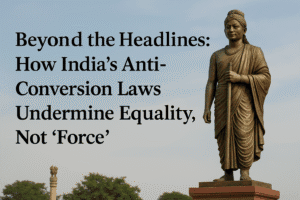Beyond the Headlines: How India’s Anti-Conversion Laws Undermine Equality, Not “Force”
India celebrates Emperor Ashoka’s voluntary conversion to Buddhism as a national legacy, yet its modern anti-conversion laws fundamentally contradict this history by assuming conversions are typically forced. These laws selectively undermine constitutional religious freedom by imposing intimidating bureaucratic hurdles – like requiring 60-day advance notices to officials and court affidavits – primarily targeting those leaving Hinduism, especially marginalized Dalits and lower-castes seeking dignity.
The “forced conversion” justification repeatedly fails evidentiary scrutiny, revealing the laws’ true function: preserving rigid social hierarchies by preventing vulnerable groups from escaping caste oppression through faith change. This discriminatory legal framework disproportionately burdens non-elites, fuels vigilante violence against minorities, and has contributed to India’s inclusion on global lists of dangerous places for religious converts.
Ultimately, the laws prioritize elite Hindu sensitivities over equal rights, betraying both Ashoka’s legacy of choice and India’s constitutional promise of religious freedom for all citizens.

India proudly venerates Emperor Ashoka, the mighty ruler who embraced Buddhism over Hinduism 2,400 years ago. His conversion, a cornerstone of Indian history taught in every school, stands as a timeless testament to personal religious choice. Yet, modern India increasingly enacts laws predicated on the very opposite notion: that religious conversions are primarily acts of coercion. This fundamental contradiction exposes the selective erosion of religious freedom at the heart of India’s anti-conversion legislation.
The Legal Contradiction: Freedom vs. Control
India’s Constitution explicitly guarantees the right to freely profess, practice, and propagate religion. As legal scholar Alok Prassana Kumar pointedly asked regarding these laws: “Constitutionally, one can choose one’s religion or choose none at any point of time in one’s life. The Constitution doesn’t say one is free to practice only one’s birth religion… So where do ‘anti-conversion laws’… fit in?”
The answer lies not in protecting individuals, but in controlling them. These laws, enacted in ten states with varying strictness, share intrusive mechanisms designed to deter conversion, particularly out of Hinduism:
- The Bureaucratic Gauntlet: Converts, often from marginalized communities, must navigate intimidating requirements. This includes obtaining certificates from officials and filing affidavits in court declaring their conversion was “voluntary.” As noted in reports, these officials are frequently upper-caste elites, creating a climate of fear for Dalits and other lower-caste individuals seeking change.
- Pre-Conversion Surveillance: States like Uttar Pradesh demand individuals give authorities 60 days’ notice before converting. Religious leaders must also notify the state a month in advance. This transforms a personal spiritual decision into a matter of state scrutiny long before it happens.
Challenging the “Force” Narrative
The primary justification for these laws – preventing “forced conversions” – crumbles under scrutiny. Kumar highlights a critical flaw: investigations into alleged forced conversions consistently reveal voluntary choices. The narrative persists, however, often expanded to absurdity, potentially branding anyone advocating their faith as engaging in fraud.
The real driving force appears less about protecting vulnerable individuals and more about preserving social hierarchies.
The Shadow of Caste: Protecting Hierarchy, Not Faith
India’s deeply entrenched caste system, despite constitutional abolition, continues to inflict discrimination and violence, particularly in rural areas. For millions of Dalits and lower-caste Hindus, converting to religions like Christianity or Buddhism isn’t merely a spiritual shift; it’s often a quest for dignity, community, and escape from oppressive social stigmas.
This is the conversion anti-conversion laws most effectively target: the movement of non-elites away from the fold. The laws disproportionately burden those seeking to leave Hinduism, effectively making an individual’s birth religion a state-mandated identity for the most vulnerable. As global recognition of caste discrimination grows (evidenced by institutions like Harvard adding caste protections), these laws function to maintain the status quo that benefits the elite.
The Cost of Control: Violence and International Shame
The consequences are severe and tangible:
- Selective Freedom: The laws explicitly target conversion from Hinduism, creating a discriminatory system where the right to choose one’s faith is unequally applied.
- Fueling Persecution: These laws provide legal cover and justification for vigilante groups and others to harass, intimidate, and attack religious minorities, particularly converts. They create an environment where conversion is seen as inherently suspect or illegal.
- Global Reputation: India’s inclusion on lists like Open Doors’ “World Watch List” of dangerous places for Christians is significantly attributed to these laws and the violence they enable – a stark betrayal of Ashoka’s legacy of non-violence (ahimsa).
Ashoka’s Ghost: A Legacy Betrayed
If Emperor Ashoka were to witness modern India, the irony would be profound. The nation celebrates his voluntary conversion as a pivotal, enlightened moment in its history, yet actively enacts laws making similar choices fraught with danger and bureaucratic oppression for its own citizens, especially the most marginalized. The anti-conversion laws are less about preventing force and more about enforcing conformity, protecting caste privilege, and selectively denying the fundamental freedom of conscience promised to all Indians. Reclaiming Ashoka’s true legacy would require dismantling these barriers to genuine religious choice.
You must be logged in to post a comment.